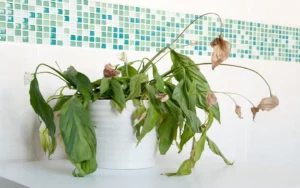Houseplants are a beautiful addition to any home, bringing life and vibrancy to indoor spaces. However, it can be disheartening to see your beloved houseplant wilting. Wilting is a sign of distress and indicates something is wrong with your plant. This article will explore why houseplants wilt and provide practical solutions to revive them. By understanding the underlying causes, you can take appropriate measures to ensure the health and vitality of your indoor greenery.

Insufficient Watering
One of the most common causes of wilting in houseplants is insufficient watering. When a plant lacks water, it cannot carry out essential functions like nutrient absorption and photosynthesis. Signs of underwatering include drooping leaves, dry soil, and a general lack of vigor. Developing a suitable watering routine for your plant species is crucial in resolving this issue. Factors such as the type of plant, pot size, and environmental conditions will influence watering frequency. Regularly check the moisture level of the soil and adjust your watering accordingly. Remember not to overwater, as it can lead to root rot and further damage the plant.
Overwatering and Poor Drainage
While underwatering can cause wilting, overwatering is equally detrimental. When the roots are consistently submerged in waterlogged soil, they lack access to oxygen, leading to root suffocation and eventual wilting. Signs of overwatering include yellowing leaves, foul odor from the soil, and soggy or waterlogged soil. To address this issue:
Ensure that your houseplant is potted in a container with proper drainage holes.
Use well-draining potting soil and water only when the top inch of the soil feels dry.
If you suspect overwatering has occurred, allow the soil to dry out before watering again.
Read more about best houseplants
Environmental Factors
Environmental conditions play a crucial role in the health of houseplants. Extreme temperatures, drafts, low humidity, and inadequate light can all contribute to wilting. Plants have specific temperature preferences, so ensure your houseplant is placed in an area with suitable temperatures. Avoid exposing plants to cold drafts or hot, direct sunlight, which can cause stress and lead to wilting. Additionally, some plants require higher humidity levels, especially in dry indoor environments. Mist the leaves or place a water tray near the plant to increase humidity. Understanding and managing these factors will help ensure a favorable environment for your houseplants.
Temperature: Different plant species have specific temperature preferences. Extreme hot and cold temperatures can stress plants and lead to wilting. It’s important to place your houseplant in an area with suitable temperatures. Most houseplants thrive in temperatures between 60°F (15°C) and 75°F (24°C). Avoid placing plants near drafts, such as air conditioning vents, open windows, or doorways, as sudden temperature fluctuations can shock the plant. Also, be cautious of placing plants near heat sources like radiators or direct sunlight, as excessive heat can dehydrate the plant and cause wilting. Monitor the temperature near your houseplants and adjust their placement accordingly.
Drafts: Cold drafts can be particularly damaging to houseplants. Exposure to drafts can cause stress and result in wilting. Cold air drafts can disrupt the plant’s ability to regulate moisture levels and transpire properly. Avoid placing your houseplants in areas prone to drafts, such as near windows or doors. If drafts are unavoidable, consider using draft stoppers or moving the plants slightly further away from the source of the draft.
Humidity: Indoor environments tend to have lower humidity levels than many houseplants’ natural habitats. Low humidity can cause water loss through the plant’s leaves, leading to wilting and dryness. Some plants, such as ferns or tropical varieties, thrive in higher humidity. Increase humidity around your plants by misting them regularly with water, placing a water tray near the plants, or using a humidifier in the room. Grouping plants can also create a microclimate with increased humidity. Be cautious not to over-mist the leaves, as excessive moisture can lead to fungal diseases.
Light Exposure: Light is essential for photosynthesis, the process through which plants convert light energy into chemical energy for growth. Insufficient or excessive light exposure can result in wilting. Different plant species have varying light requirements, ranging from low to bright, indirect, or even direct sunlight. Assess the light conditions in your home and place your houseplants accordingly. If a plant is not receiving enough light, it may become weak and exhibit signs of wilting. Conversely, too much direct sunlight can cause heat stress and damage the plant’s leaves. Find a balance and provide your houseplants with the appropriate amount and quality of light they need.
Air Circulation: Good air circulation benefits houseplants as it helps prevent stagnant air and discourages the growth of pests and diseases. However, excessive air movement, especially from fans or drafts, can lead to increased transpiration and water loss, resulting in wilting. It’s important to balance providing adequate air circulation and avoiding direct, strong drafts that may cause stress to the plant. Consider using low-set fans or gently opening windows to promote gentle airflow.
Nutritional Deficiencies
Like any living organism, houseplants require a balanced diet of nutrients to thrive. Nutritional deficiencies can weaken a plant, making it more susceptible to wilting. The three primary macronutrients for plants are nitrogen (N), phosphorus (P), and potassium (K). Micronutrients like iron, magnesium, and zinc are also crucial for healthy growth.

Signs of nutrient deficiencies include yellowing or discolored leaves, stunted growth, and overall poor plant vigor. To address this issue, use a balanced fertilizer formulated for indoor plants. Follow the instructions and adjust the feeding schedule based on the plant’s needs.
Pest Infestation
Pests can wreak havoc on houseplants, causing damage to leaves, stems, and roots. Common pests include spider mites, aphids, and mealybugs. These pests can weaken the plant’s ability to absorb water and nutrients, resulting in wilting. Inspect your plant regularly for signs of infestation, such as webs, sticky residue, or small insects. If pests are detected, isolate the affected plant to prevent further spread and treat it with appropriate organic or chemical pest control methods.
KEYWORDS:

